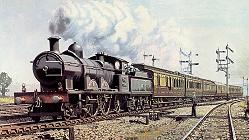April 16, 1853, Indian Railway History made debut on a public day off in Bombay. All over the early mid-afternoon, crowds of holiday makers could be seen making their way to Bori Bunder from where floated strains of music, rendered by the Governor’s personal band. Shortly before 3.30 p.m., 400 privileged personalities of the city climbed aboard the centre of the day’s festivities – the 14 gleaming carriages of the Great India Peninsula Railway, coupled behind a small steam engine, named the Falkland.
 At the stroke of the half-hour, the driver of the Falkland opened the engine valves, as his fireman shovelled vigorously. The Falkland breathed heavily, enveloping bystanders in a cloud of steam. The driver reached for the whistle chord, the crowd cheered lustily and the boom of the first volley of a 21 gun salute resounded through the moist heat of the afternoon.
At the stroke of the half-hour, the driver of the Falkland opened the engine valves, as his fireman shovelled vigorously. The Falkland breathed heavily, enveloping bystanders in a cloud of steam. The driver reached for the whistle chord, the crowd cheered lustily and the boom of the first volley of a 21 gun salute resounded through the moist heat of the afternoon.
A final signal of the whistle, a final snort from Falkland and India’s first railway train edged forward, puffing and hissing and groaning through the 35 kilometres to Thana.
Indian Railway History
Almost six years later, on March 3, 1859, the first Railway Line in North India was laid between Allahabad and Kanpur. This was followed, in 1889, by the Delhi – Ambala – Kalka line. This is a very important of Indian railway history in making india as a country which it is these days.
From these modest beginnings, the Indian Railways have grown to become the world’s largest network under a single management.
Administratively, the Indian Railways have been divided into sixteen zones, each headed by a General Manager and further sub-divided into divisions, each headed by a Divisional Railway Manager.
Northern Railway was erstwhile a grand eight-divisional zone- comprising of Allahabad, Bikaner, Jodhpur, Delhi, Moradabad, Ferozpur, Ambala and Lucknow embracing most of North India. With the re-organisation of zones, the Railway is now a vibrant five-star constellation viz. , Delhi, Moradabad, Ferozpur, Ambala and Lucknow.
The Northern Railway, which came into existence in its present form in 1952, is one of the Indian Railways largest zone.
Northern Railway has been, and is, the pioneer in innovation and modernization. The enterprising path of technological advancements and innovations on Indian Railways are ubiquitous all-over India; but it is a matter of pride that the journeys have in the most part begun on Northern Railway.
The computerized passenger reservation system was first introduced here, on February 19,1986. For the convenience of our customers, we have also provided Interactive Voice Response Systems (IVRS), Electronic Display Systems at stations, Recorded Coach Guidance Display System, Reservation Availability Position Information Display (RAPID), Self Dial Telephone Reservation Enquiry Booths (I ASK), Automatic Teller Machines (ATM) and Money Changing Facilities at Stations.
To ease the unreserved travellers to also plan their journey ahead, Northern Railway has bring together the Unreserved Ticketing System (UTS) whereby the unreserved rail passenger can purchase an unreserved ticket 3 days in advance from the current booking counters.
Northern Railway has presented the first diesel and electric locomotive simulators in India at the Tughlakabad and Kanpur locomotive sheds. These help upgrading the skills of the working and new drivers, providing them training for high speed train operation. All workshops, Diesel sheds and Air brake freight depts. are ISO 9000 certified. Diesel shed, Tughlakabad has the distinction of being the first diesel shed to get 14000 certification on Indian Railway. Other diesel sheds and workshops are also going for ISO-14000.
For improving efficiency and safety in their operations, modern signalling plays a vital role. The progress from a rudimentary interlocked system to a Route Relay Interlocked system has been a historical one. Northern Railway is equipped with 40 RRIs which includes Delhi Main RRI, which is the largest RRI System in the world, a fact certified by the Guinness Book of Records.
Our headquarters is at Baroda House, New Delhi, with Divisional headquarters at Ambala,Delhi, Firozpur, Lucknow and Moradabad. We serve eight states – Delhi, Haryana, Himachal Pradesh, Jammu & Kashmir, Punjab, Uttaranchal and Uttar Pradesh and the Union Territory of Chandigarh.
